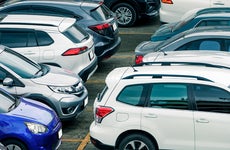Commuter vs. pleasure car insurance

The Bankrate promise
At Bankrate, we strive to help you make smarter financial decisions. To help readers understand how insurance affects their finances, we have licensed insurance professionals on staff who have spent a combined 47 years in the auto, home and life insurance industries. While we adhere to strict , this post may contain references to products from our partners. Here's an explanation of . Our content is backed by Coverage.com, LLC, a licensed entity (NPN: 19966249). For more information, please see our .
When applying for a car insurance policy, you may be asked about the primary use of your vehicle and average annual mileage. Although your vehicle’s age, make and model impact insurance rates, how and when you use your car also influences your cost of car insurance. Two of the most common uses for cars are commuting and driving for pleasure. Let’s take a look at how each scenario may impact your car insurance rates.
Do I need different car insurance for commuting vs. pleasure driving?
The amount of car insurance coverage you purchase and the best company for your insurance needs may vary based on how you use your car. For example, you might choose full coverage car insurance for a vehicle that you often drive in congested commute traffic or park in a busy city where vandalism could be more common. On the other hand, if you have an older car that you only use for occasional trips to the grocery store, it may not be worth it to pay for full coverage. Let’s take a look at how different vehicle use scenarios may impact your insurance needs and rates.
Car insurance for pleasure driving
If you do not use your vehicle to commute to work, regularly transport your children or run daily errands, your car’s primary purpose may be pleasure driving. Pleasure vehicles are typically not driven on a daily basis. This may be a good fit for people with sports cars or classic cars that are not suitable for daily commuting but are still driven from time to time.
For example, you may use the car for things like running errands, going to the grocery store or driving to the neighborhood bistro for a meal with friends. Maybe it is your favorite vehicle for weekend adventures or road trips with your friends. Either way, this is a car that is usually only driven occasionally, such as only on the weekends and at night. Regardless of when you use it, this vehicle is not used nearly as often as a commuter vehicle and likely spends most of the time in your garage or your driveway.
Car insurance for commuting
A commuting vehicle is much different from a pleasure vehicle. This is a primary vehicle that is used to transport you and your family to work and school each day. As your regular transportation, you spend much more time in this vehicle than you do in a pleasure vehicle. Therefore, your commuting car typically faces a much higher risk on the road than your pleasure vehicle that is only driven occasionally.
Why does my insurance company care how I use my car?
When car insurance companies determine the cost of your auto insurance, one of the factors that matter most is the risk that you pose to the company. If there is a higher likelihood of you filing a claim in the future, a company will adjust your rates accordingly to help cover that risk.
Car insurance companies typically charge higher rates for vehicles used for commuting or other regular use cases. More frequent driving, especially during busy driving hours, increases the risk of an accident and claim, so most companies increase rates to compensate for this. Additionally, if you are commuting to a more populated city, this may also exacerbate your risk for accidents, theft and vandalism.
Is car insurance more expensive for commuting than pleasure driving?
Commuter car insurance is typically more expensive than pleasure insurance because commuter cars are used more frequently than pleasure vehicles. All of those extra miles on the road increase your risk of an accident and damages to your car, especially when you have so many cars on the road around you, like during rush hour. The distance you travel can also impact your insurance rates, with insurance companies often rewarding low-mileage drivers with cheaper rates than the ones that long-distance commuters can face.
While pleasure vehicles that are used less frequently typically see lower rates based on their lower annual mileage, your vehicle’s make and model still play a role in determining your rates. For example, if your pleasure vehicle is a foreign-made sports car, you may actually pay higher rates as most companies see sports cars as riskier to insure, and parts and repairs for foreign-made cars may be more expensive. Alternatively, if the car you use to commute has high safety ratings and accessible parts, you might not pay too much more based on how often you use it.
Note that vehicle type and use are only two factors out of many that contribute to car insurance costs. In most states, personal rating factors such as driving record, age and credit history all affect your car insurance rates. If you’re seeing surprisingly high auto insurance quotes for your commuter or pleasure vehicle, other factors may be at play.
Frequently asked questions
-
-
There is no defined coverage option or pricing metric for commuter vs. pleasure vehicles. Most drivers use their cars for both, so questions during the insurance quoting process reflect this. If you use your car for both commuting and pleasure, you will likely see a rate that reflects this frequent usage. If you have questions about how your car use impacts your insurance costs, you may want to speak with a licensed insurance agent or broker about your coverage options based on your unique driving habits.
-
The only car insurance coverage you are required to carry is enough to meet your state’s minimum car insurance requirements and any additional coverage requirements imposed by your lender if you lease or finance your vehicle. That said, you may want to purchase additional coverage types or higher limits if you feel that your commute adds additional risk of damage to your vehicle. Ultimately, how much coverage you need for your commuter car likely depends on where you live and work, your vehicle type, your budget and your comfort with risk.
-
Nonstandard insurance is a type of non-traditional insurance that some car insurance companies offer. Nonstandard coverage is designed for high-risk drivers that may have difficulty securing coverage from a standard carrier. This may include drivers with DUIs, multiple speeding tickets or multiple accidents. Coverage options may be limited with nonstandard carriers, and coverage is typically more expensive to account for the high-risk drivers the carriers write policies for.
-
Related Articles



